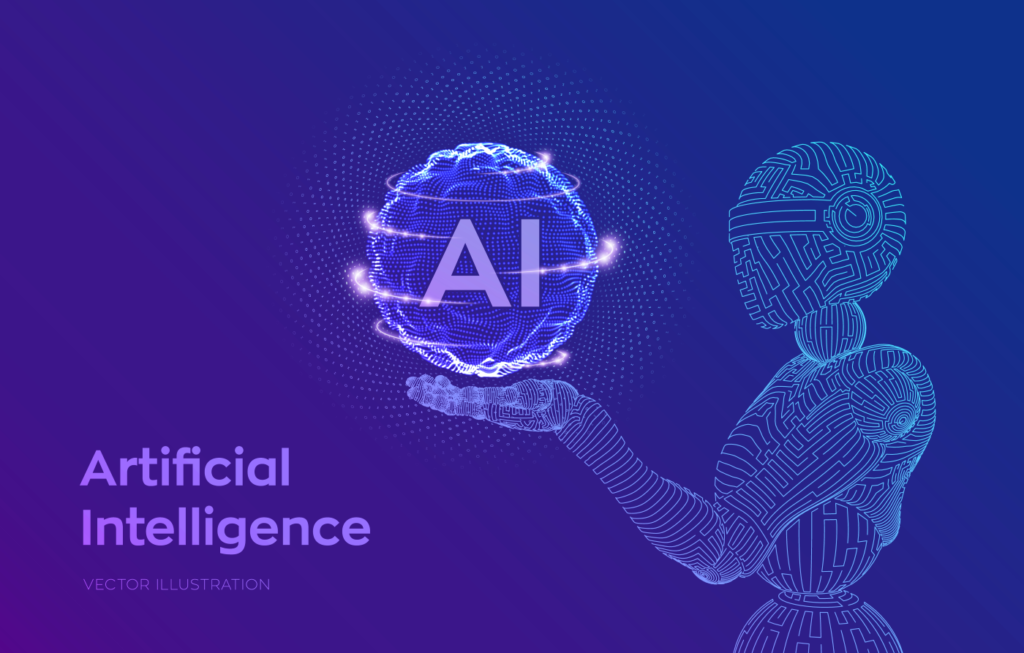This quote appears frequently these days – “Artificial Intelligence is the future.” However, what does it entail? It is quite confusing to figure out what all these fancy terms such as AI, GAI, ML, LLM, GANs, and GPTs mean in the current business environment. This exhaustive guide will demystify both these terms as we explain them one by one. This article is for you, if you are an AI aficionado or just want to learn more about the subject.
Table of Contents
AI: Artificial Intelligence

Artificial Intelligence (AI): Artificial Intelligence or often simply said AI, refers to creating the computers capable of performing the tasks those are usually done by human with their intelligence. These include a range of domains such as, problem solving, pattern recognition, understanding of natural languages, and decision-making. AI systems are programmed to become better with each new experience which they learn from, as well as adjusting themselves to any given input that may help them increase efficiency or performance rating.
Applications of AI
Applications of artificial intelligence span across different sectors. Here are some examples:
- Healthcare: Diagnosis of disease, prediction of outcomes in patients, and creation of individual therapeutic regimens are implemented through AI. It can also assist in the process of drug discovery and conduct of the clinical trials
- Finance: Fraud, anti-money laundering, risk management, and algorithmic trading are some of its application areas. Its other uses include customer service and personal finance management.
- Education: Personalized learning, automatic grading, intelligent tutoring system using the AI technology. They can also be used to improve on student retention and involvement.
- Transportation: For autonomous vehicles, traffic management, predictive maintenance, among others. it helps with coordination in logistics and supply chain management.
- Entertainment: Content recommendation, targeted advertising, and game development make use of AI. It, therefore enhances music and video production.
- Retail: AI helps in stockpiling, anticipation of consumer demands, as well as client services. In addition, it may be used in making product recommendations and pricing optimization
- Manufacturing: Quality control, predictive maintenance and also optimizing the supply chain using AI. Automated tests can also be used in process automation and defect detection.
- Agriculture: Among them, AI is utilized in the realm of monitoring crops, determining yields, and analyzing soils. It is beneficial for precise farming and pest control.
Some of the ways in which artificial intelligence are being utilized currently include these samples. With time, AI technology will become further advanced and produce even more amazing applications.
Read more: Impact of Technology on Jobs – Top 10 Must Know Impacts and Actionable
General Artificial Intelligence (GAI)

GANs are a specific type of machine learning model used for generative tasks. GAI is the intelligence equivalent of GA that surpasses that of humans with regard to different intellectual abilities. The purpose of GAI is to imitate human intelligence and simulate human mental understanding, reasoning, and problem-solving approaches. However, we should note that though the GAI is a long-term target of development, the present direction is towards the Narrow AI that has the potential to provide remarkable performance in individual activities.
ML: Machine Learning

Among different areas of AI, Machine Learning (ML) is one of the most important categories that involves teaching computers how to act wisely based on accumulated data instead of writing detailed codes for them. It includes designing algorithms and models which can themselves perform better by analyzing huge data volumes without any human intervention. With respect to ML algorithms, such algorithms are used in identifying patterns out of the data that they have learnt.
3 Types of LLMs (Large Language Models)
In Machine Learning, there are three main types of learning approaches:
Supervised Learning:
This kind of approach involves training a model using labeled data in which the outcome is known beforehand. This labelled data teaches the model how to predict on any other unlabeled data.
Unsupervised Learning:
Contrary to the supervised learning approach, unsupervised learning operates on unlabeled data. Without prior knowledge, the model reveals structural patterns in the data, which it uses to predict an outcome. Its function is to unveil previously undiscovered relations between pieces of data or to reveal some hidden clusters in it.
Reinforcement Learning:
In this approach, an agent learns to act on an environment and optimizes reward through appropriate actions. Thus, the agent is rewarded or penalized, and this encourages it to select the best course of action.
GANs: Generative Adversarial Networks

Generative Adversarial Networks (GANs) are a specific class of ML models consisting of two components: a generator and a discriminator. The generator produces artificial datasets while the discriminator attempts to differentiate the genuine from the fake data. The generator refines itself in how it produces more realistic data, while the discriminator gets better at differentiating between true and false data. Noteworthy is the role played by GANs in creating authentic images, clips and even tunes.
GPTs: Generative Pre-trained Transformers

GPTs is one among the various AI models based on the use of both deep learning and transformer. The GPT, therefore, can generate any text that may appear natural in relation to a given prompt or context. The models are trained on large volumes of text that enables them to understand sophisticated word connections and produce well-ordered sentences with meaning. Some of these applications include content creation, transcreation, as well as chat bots.
Summary
This guide examined the essential elements of AI, GAI, ML, LLM, GANs, and GPTs.
- AI is a process involving designing machines meant for carrying out work only done by brains before.
- The goal of GAI is human-level intelligence in different areas.
- ML involves teaching systems how to learn from the data through a process called supervised, unsupervised and reinforcement learning.
- The generative adversarial networks (GAN) are machine learning models that generate synthetic data in competition with a discriminator.
- GPTs refer to AI text generators which leverage pre-learned information to produce human-like copies.
Conclusion
Having acquired these insights about AI, GAI, ML, LLM, GANs, and GPTs, it is possible for you to intelligently move in any discussion or argument that pertains to Artificial Intelligence. The concepts will be even more important with advancing technology in developing our future. Therefore, fasten your seat belts as you prepare to enjoy the amazing possibilities of artificial intelligence (AI), generative artificial intelligence (GAI), machine learning (ML), language learning model (LLM), generative adversarial networks (GANs) and GPT technologies.
FAQs
Q1. How can I learn more about AI?
- One can find a lot of information about AI on the internet. Here are some of the best ones:
DataCamp: DataCamp provides an extensive AI curriculum encompassing the essentials of Python coding through sophisticated machine learning methods. Their blog is also with different articles about AI.
Coursera: For instance, Coursera has AI courses from many famous universities and worldwide institutions. Some of the most common lessons are, “Introduction to Artificial Intelligence” and “Machine Learning”
DeepLearning.AI: DeepLearning.AI provides several learning tools for AI, such as eBooks, instructional guides, course slides, and many others. Three, they operate their own youtube with different AI-related videos
Medium: There are many articles about AI and machine learning written by experienced people in the medium. From simple to complex, everything is covered including; artifical intelligence, deep learning and neural networks.
Pure AI: Pure AI has created a directory that contains resources for AI and machine learning skills at absolutely no cost. It contains books, training courses, datasets and toolkits 5
I hope these tools assist in starting your AI learning journey.
Q2. Can you give me an example of a real-world application of GANs?
- There are many real-world applications of GANs. Here are some examples:
- Video Game Development: First, GANs are particularly useful in creating new photorealist scenes for video games, movies, and television
- Fashion Industry: In fashion, one could use GANs to turn the designer’s sketch into a photo that looks believable.
- Architecture: Partial face images can be rotated using GANs to improve their use for facial recognition.
- Medical Imaging: Second, GANs are able to produce artificial medical images for teaching machine-learning algorithms.
- Artificial Voice Generation: With GAN, it is possible to create a fake voice that imitates the human voice.
- Image Editing: This means that GANs can be used to change the color of an object or to delete unwanted items from an image 3
- Data Augmentation: Synthetic data generated by GANs can be applied as additional input to existing datasets, thus extending its capacity for machine learning purposes.
Some specific application areas for GAN include these. The development of GANs will most likely result in numerous upcoming revolutionary applications as time goes by.
Q3. How do I train a GAN model?
- Training a GAN model involves several steps. Here is a general outline of the process:
- Prepare the data: The first stage is to make sure that you have ready data for training of the GAN. Data collection, clean up, and splitting into the training and validation sets.
- Define the architecture: Then, we will discuss the construction of the GAN. Here, one should define the number, types of layers and the activation function.
- Train the discriminator: To distinguish between data sets, the discriminator is exposed to data sets. It intends to make the discriminator as precise as possible.
- Train the generator: To create realistic forgeries, a generator is made to produce information that would dupe discriminator. This will enable a generator to be trained to produce fake data which are as genuine as can be.
- Fine-tune the GAN: After the discriminator and generator have been trained, the two models merge into one fine-tuned system. This entails adjusting the hyperparameters in order to improve the GAN performance.
Q4. Can you give me an example of a real-world application of LLMs?
- LLMs have a wide range of applications in various fields. Here are some examples:
- Chatbots and Virtual Assistants: For example, Chatbots or Virtual Assistants using the LLMs may understand and respond to specific natural language questions directly. Such systems can also create realistic human-related text for use in computerized customer services.
- Content Generation: LLM algorithms can develop high quality content that supports different uses, like news articles, products description, or even social media posts. In addition, they can serve as abstracts in describing lengthy narratives and provide comments on pictures.
- Language Translation: It is possible for them to assist in translating a text from a foreign language into English or vice versa. Additionally, they are also used to produce multilingual text.
- Speech Recognition: LLMs are also useful for taking speech and converting it to text, among other things. They also are a good source of creating synthetic talking that mimics genuine human voice.
- Search Engines: Search engines also rely on LLMs to ensure that generated results are more accurate and relevant. Also, they assist in comprehension of user’s intention and delivering personalized search results.
- Autonomous Vehicles: The language models can assist in autonomous machines for deciphering and reacting the same language instructions. These can also be converted into textual instructions suitable for a driver using text-to-speech technology.
Below are some instances where LLMs has been employed in actual environments. With time, there will be many more cutting-edge ideas that will utilize the evolving LLM technologies.
You may also be interested in knowing:
How to Prepare Oats for Weight Loss, Muscle Gain, Babies, Pregnancy & Diabetic Patients
How to Prepare Detox Water for Good Health, Weight Loss & Clear Skin – 13 Recipes
How to Increase Hemoglobin in a Week Vegetarian – Top 10 Foods
Should I Buy Flowers on the First Date? Get Clarity with 5 Choices
What Should be the Density of Petrol? All 5 Wise Things You Need to Know
Should I Travel During Solar Eclipse? Mythological, Scientific and Practical all 3 Perspectives
101 Gen Z Slangs, Lingos & Phrases Cheat sheet – Parents Must Know in 2024 for not Becoming Cheugy
3 thoughts on “Guide to Understand “AI, GAI, ML, LLM, GANs, and GPTs””